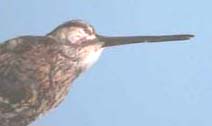Snipe
 Snipe common name for shorebirds of three genera of the sandpiper family. Snipes breed abundantly on all continents except Australia (where, however, one species winters). Snipes have long, slender bills, sensitive at the tip, which are used to probe for worms and grubs in swampy grasslands. They are highly regarded as game birds because of their twisting, erratic flight after they are flushed.
Snipe common name for shorebirds of three genera of the sandpiper family. Snipes breed abundantly on all continents except Australia (where, however, one species winters). Snipes have long, slender bills, sensitive at the tip, which are used to probe for worms and grubs in swampy grasslands. They are highly regarded as game birds because of their twisting, erratic flight after they are flushed.
A typical species is the common snipe of Eurasia and North America, where it was long known as Wilson's snipe. It is mottled and striped with brown, black, and buff and is about 28 cm (about 11 in) in length. In courtship the male performs acrobatic revolutions in flight and drops suddenly from a height, producing a drumming beat as the air rushes past the quills in its tail.
Identification Tips:
|
|---|
In spring, snipe perform spectacular displays high in the sky. Each male, following a circular route, makes a series of power dives during which the outermost tail-feathers are held out almost at right-angles to the bird's body. Feather vibration produces the remarkable throbbing known as 'drumming'. Drumming takes place throughout the breeding season —can be enjoyed on moonlit nights.
Once a female snipe is attracted, the male pursues her and dives with wings held above the body in a V-shape often rolling and turning upside-down. The male takes no part in incubation, continuing drumming displays over the nesting territory. He feeds mostly at night, spending much of the day resting in cover.